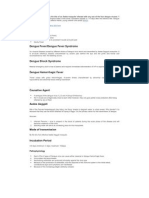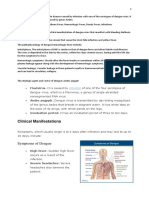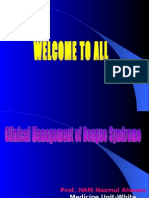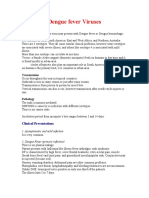Denguedhf Information For Health Care Practitioners 2009
Denguedhf Information For Health Care Practitioners 2009
Uploaded by
Nateen MyanmarCopyright:
Available Formats
Denguedhf Information For Health Care Practitioners 2009
Denguedhf Information For Health Care Practitioners 2009
Uploaded by
Nateen MyanmarOriginal Description:
Original Title
Copyright
Available Formats
Share this document
Did you find this document useful?
Is this content inappropriate?
Copyright:
Available Formats
Denguedhf Information For Health Care Practitioners 2009
Denguedhf Information For Health Care Practitioners 2009
Uploaded by
Nateen MyanmarCopyright:
Available Formats
U.S.
DEPARTMENT OF HEALTH AND HUMAN SERVICES
Centers for Disease Control and Prevention
Dengue and
Dengue Hemorrhagic Fever
Information for Health Care Practitioners
Dengue is a mosquito-borne disease caused by any one of four closely related dengue viruses
(DENV-1, -2, -3, and -4). Infection with one serotype of DENV provides immunity to that
serotype for life, but provides no long-term immunity to other serotypes. Thus, a person can
be infected as many as four times, once with each serotype. Dengue viruses are transmitted
from person to person by Aedes mosquitoes (most often Aedes aegypti) in the domestic
environment. Epidemics have occurred periodically in the Western Hemisphere for more
than 200 years. In the past 30 years, dengue transmission and the frequency of dengue
epidemics have increased greatly in most tropical countries in the American region.
Clinical Diagnosis Dengue Hemorrhagic Fever
and Dengue Shock Syndrome
Dengue Some patients with dengue fever go on to develop
Classic dengue fever, or “break bone fever,” is dengue hemorrhagic fever (DHF), a severe and
characterized by acute onset of high fever 3–14 days sometimes fatal form of the disease. Around the time
after the bite of an infected mosquito. Symptoms the fever begins to subside (usually 3–7 days after
include frontal headache, retro-orbital pain, myalgias, symptom onset), the patient may develop warning
arthralgias, hemorrhagic manifestations, rash, and signs of severe disease. Warning signs include severe
low white blood cell count. The patient also may complain abdominal pain, persistent vomiting, marked change
of anorexia and nausea. Acute symptoms, when present, in temperature (from fever to hypothermia),
usually last about 1 week, but weakness, malaise, and hemorrhagic manifestations, or change in mental
anorexia may persist for several weeks. A high proportion status (irritability, confusion, or obtundation). The
of dengue infections produce no symptoms or minimal patient also may have early signs of shock, including
symptoms, especially in children and those with no restlessness, cold clammy skin, rapid weak pulse, and
previous history of having a dengue infection. narrowing of the pulse pressure (systolic blood
pressure − diastolic blood pressure). Patients with
The main medical complications of classic dengue dengue fever should be told to return to the hospital
fever are febrile seizures and dehydration. if they develop any of these signs.
Treatment of dengue fever emphasizes
• Relieving symptoms of pain. DHF is currently defined by the following four
• Controlling fever. World Health Organization (WHO) criteria:
• Telling patients to avoid aspirin and other • Fever or recent history of fever lasting 2–7 days.
nonsteroidal, anti-inflammatory medications • Any hemorrhagic manifestation.
because they may increase the risk for hemorrhage. • Thrombocytopenia (platelet count
• Reminding patients to drink more fluids, of <100,000/mm3).
especially when they have a high fever. • Evidence of increased vascular permeability.
Dengue and Dengue Hemorrhagic Fever | 1
The most common hemorrhagic manifestations
are mild and include a positive tourniquet test, skin
hemorrhages (petechiae, hematomas), epistaxis
(nose bleed), gingival bleeding (gum bleed), and
microscopic hematuria. More serious types of
hemorrhage include vaginal bleeding, hematemesis,
melena, and intracranial bleeding.
Evidence of plasma leakage due to increased vascular
permeability consists of at least one of the following:
• An elevated hematocrit ≥20% above the
population mean hematocrit for age and sex.
• A decline in hematocrit after volume-replacement
treatment of ≥20% of the baseline hematocrit.
• Presence of pleural effusion or ascites detected
by radiography or other imaging method.
• Hypoproteinemia or hypoalbuminemia as
determined by laboratory test. A female Aedes aegypti mosquito obtaining a
blood-meal from a human host through her proboscis,
WHO is currently reevaluating the clinical case which penetrates the host’s skin.
definition for dengue fever and DHF. Studies from
different countries have reported life-threatening (1) rapid, weak pulse and narrow pulse pressure
complications from dengue in the absence of one or (≤20 mmHg [2.7 kPa]) or (2) hypotension for age,
more of the current criteria for DHF. Despite the restlessness, and cold, clammy skin. Patients with
name, the critical feature that distinguishes DHF dengue can rapidly progress into DSS, which, if not
from dengue fever is not hemorrhaging, but rather treated correctly, can lead to severe complications
plasma leakage resulting from increased vascular and death.
permeability.
Fatality rates among patients with DSS can be 10%
Dengue shock syndrome (DSS) is defined as any or higher but, with early recognition and treatment,
case that meets the four criteria for DHF and can be less than 1%. DHF and DSS can occur in
has evidence of circulatory failure manifested by both children and adults.
What to Look for When You Evaluate Patients for DHF
EVALUATE the patient’s heart rate, capillary refill, skin color and temperature,
peripheral pulse volume, pulse pressure, and blood pressure. A drop in systolic
blood pressure is usually the last sign and appears only when the patient is in shock.
LOOK FOR evidence of bleeding on the skin and at other sites.
LOOK FOR evidence of increased capillary permeability
(e.g., pleural effusions, ascites, hemoconcentration).
MEASURE and ask about urine output.
2 | Dengue and Dengue Hemorrhagic Fever
How to Treat Dengue Fever Clinical Management
Even for outpatients, stress the need to maintain
• Tell patients to drink plenty of fluids adequate hydration. Monitoring for warning signs
of severe dengue and initiating early appropriate
and get plenty of rest. treatment are key to preventing complications such
• Tell patients to take antipyretics to as prolonged shock and metabolic acidosis. Successful
management of DHF and DSS includes judicious
control their temperature. Children and timely IV fluid replacement therapy with
with dengue are at risk for febrile isotonic solutions and frequent reassessment of the
patient’s hemodynamic status and vital signs during
seizures during the febrile phase the critical phase. Health care providers should learn
of illness. to recognize this disease at an early stage. To manage
pain and fever, patients should be given acetaminophen.
• Warn patients to avoid aspirin Aspirin and nonsteroidal, anti-inflammatory
and other nonsteroidal, medications may aggravate the bleeding tendency
associated with some dengue infections and, in
anti-inflammatory medications children, can be associated with the development
because they increase the risk of Reyes syndrome.
of hemorrhage.
• Monitor your patients’ hydration Laboratory Diagnosis
status during the febrile phase Unequivocal diagnosis of dengue infection requires
of illness. Educate patients and laboratory confirmation, either by isolating the virus
or detecting dengue-specific antibodies. For virus
parents about the signs of isolation or detection of DENV RNA in serum
dehydration and have them monitor specimens by serotype-specific, real-time reverse
transcriptase polymerase chain reaction (RT-PCR),
their urine output. an acute-phase serum specimen should be collected
• If patients cannot tolerate fluids within 5 days of symptom onset. If the virus
cannot be isolated or detected from this sample,
orally, they may need IV fluids. a convalescent-phase serum specimen is needed at
Assess hemodynamic status least 6 days after the onset of symptoms to make a
serologic diagnosis by testing for IgM antibodies to
frequently by checking the patient’s dengue with an IgM antibody-capture enzyme-linked
heart rate, capillary refill, pulse immunosorbent assay (MAC-ELISA).
pressure, blood pressure, and Acute-phase and convalescent-phase serum samples
urine output. should be sent to the state health department or to
the Centers for Disease Control and Prevention (CDC)
• Perform hemodynamic assessments, for testing. Acute-phase samples for virus diagnosis
baseline hematocrit testing, and may be stored on dry ice (-70°C) or, if delivery can be
made within 1 week, stored unfrozen in a refrigerator
platelet counts. (4°C). Convalescent-phase samples should be sent in
• Continue to monitor your patients a rigid container without ice, if next-day delivery is
assured. Otherwise, they should be shipped on ice in an
closely during defervescence. insulated container to avoid heat exposure during transit.
The critical phase of dengue
Most tests for anti-dengue antibodies yield nonspecific
begins with defervescence and results for flaviviruses, including West Nile and St.
lasts 24–48 hours. Louis encephalitis viruses. Because commercial kits
may vary in sensitivity and specificity, test results
may need to be confirmed by a reference laboratory.
Dengue and Dengue Hemorrhagic Fever | 3
WORL D D I S T R I B U T I O N O F DENGUE, 2008 Dengue Risk Areas No Known Dengue Risk
Atlantic Ocean
Pacific Ocean
Indian Ocean
Pacific Ocean
the Dominican Republic, El Salvador, Guatemala,
Epidemiology Honduras, Mexico, Nicaragua, Panama, and Paraguay.
Although its contact with humans and its density in
A dengue epidemic requires the presence of urban areas are not as great as that of Aedes aegypti,
• The vector mosquito (usually Aedes aegypti). this species also can transmit dengue viruses.
• The dengue virus.
• A large number of susceptible human hosts. As noted previously, the frequency of epidemic
disease has increased significantly in the past 30
Outbreaks may be explosive or progressive, depending years. Modern transportation makes it easy for
on the density and efficiency by which the vector can travelers to visit virtually any location on the globe,
be infected, the serotype and strain of the dengue virus, including areas of the world where dengue is endemic.
the number of susceptible (nonimmune) humans in the Although travel-associated dengue and limited
population, and the amount of vector-human contact. outbreaks do occur in the continental United States,
most dengue cases in U.S. citizens occur as a result
Dengue should be considered as the possible etiology of endemic transmission in some of the U.S.
when leptospirosis, enterovirus, influenza, rubella, territories. CDC conducts laboratory-based, passive
or measles are suspected in a dengue-receptive area dengue surveillance in Puerto Rico in collaboration
(i.e., at a time and place where vector mosquito with the Puerto Rico Department of Health
populations are abundant and active). In Puerto (PRDH). The PRDH Web site provides a weekly
Rico and most countries of the Caribbean Basin, dengue surveillance report produced by CDC and
Aedes aegypti is abundant year-round. In the continental PRDH at http://www.salud.gov.pr.
United States, this species is seasonally abundant in
Arizona, Louisiana, southern New Mexico, Texas, If a dengue-like illness is observed in a person in the
Florida, Alabama, Georgia, Mississippi, North continental United States who has recently traveled
and South Carolina, Oklahoma, Kentucky, and to a tropical area, acute and convalescent blood
Tennessee. Given the competent vectors and specimens, associated clinical information, and a
susceptible population in the continental United brief travel history should be sent to the state public
States, isolated dengue outbreaks may occur (the last health laboratory with a request that the specimens
reported dengue outbreak was in Texas in 2005). be tested for dengue there or sent to CDC’s Dengue
Branch in San Juan, Puerto Rico. Contact the CDC
In 1985, a mosquito from Asia, Aedes albopictus, Dengue Branch for more information if needed.
was found in the United States. This species is now In Puerto Rico and the U.S. Virgin Islands, specimens
found in most states in the southeastern part of the and clinical information can be sent through the
United States, as well as in Argentina, Barbados, respective department of health or directly to the
Bolivia, Brazil, the Cayman Islands, Colombia, Cuba, CDC Dengue Branch in San Juan.
For further information, contact
Dengue Branch, Centers for Disease Control and Prevention; 1324 Cañada Street;
San Juan, Puerto Rico 00920-3860; Tel: (787) 706-2399; Fax: (787) 706-2496
4 | Dengue and Dengue Hemorrhagic Fever
You might also like
- DENGUE Hemorrhagic FeverDocument4 pagesDENGUE Hemorrhagic FeverTonee Marie GabrielNo ratings yet
- (29 August, 2016) Department of General Medicine PIMS IslamabadDocument43 pages(29 August, 2016) Department of General Medicine PIMS IslamabadwaseemNo ratings yet
- DengueDocument36 pagesDengueMohd Alfian Awang Ku LekNo ratings yet
- DengueDocument3 pagesDenguemommydaddyNo ratings yet
- Dengue Fever & Dengue Hemorrhagic FeverDocument31 pagesDengue Fever & Dengue Hemorrhagic FeverkamilahfernandezNo ratings yet
- OverviewDocument7 pagesOverviewroselynjallorina224No ratings yet
- Updated Management of Dengue, ImrulDocument73 pagesUpdated Management of Dengue, ImrulFaheem Ul HasanNo ratings yet
- Dengue Case DiscussionDocument16 pagesDengue Case DiscussionCorinne Fatima de AsisNo ratings yet
- MergeResult 2024 07 26 02 51 14Document27 pagesMergeResult 2024 07 26 02 51 14DeepanshuNo ratings yet
- DengueDocument9 pagesDengueWinna Gonato100% (2)
- Case Presentation 1Document37 pagesCase Presentation 1Safoora RafeeqNo ratings yet
- Etiologic Agent: Fatality As High As 40-50%Document7 pagesEtiologic Agent: Fatality As High As 40-50%Jolancr MarianoNo ratings yet
- Dengue NotesDocument6 pagesDengue NotesNaomi Cyden YapNo ratings yet
- Dengue Milanie F. Valenton Medical ResidentDocument31 pagesDengue Milanie F. Valenton Medical ResidentFrangelle Claudine ALvaradoNo ratings yet
- Dengue Hemorrhagic FeverDocument7 pagesDengue Hemorrhagic Feveredy santosoNo ratings yet
- DengueDocument30 pagesDengueMimi Saringan89% (9)
- DengueDocument22 pagesDengueAnamul MasumNo ratings yet
- Dengue Fever: Drmlpatel Associate Professor Deptt of Medicine KgmuDocument31 pagesDengue Fever: Drmlpatel Associate Professor Deptt of Medicine KgmuDurgesh PushkarNo ratings yet
- DengueDocument7 pagesDengueHafsah MangarunNo ratings yet
- INFECTIONS Dengue Fever and Dengue Hemorrhagic FeverDocument36 pagesINFECTIONS Dengue Fever and Dengue Hemorrhagic FeverDr.P.NatarajanNo ratings yet
- Prevention and Control of Dengue and Dengue Haemorrhagic FeverDocument47 pagesPrevention and Control of Dengue and Dengue Haemorrhagic FeverElfatih PublishingNo ratings yet
- Presentation On DengueDocument39 pagesPresentation On DenguearmanNo ratings yet
- 4.2. Dengue NewDocument25 pages4.2. Dengue NewshrabantncNo ratings yet
- Decee Marie T. Miranda Saint Mary'S University BSN Group6: Dengue Hemorrhagic FeverDocument5 pagesDecee Marie T. Miranda Saint Mary'S University BSN Group6: Dengue Hemorrhagic FeverJeff Mac Rae RamosNo ratings yet
- Dengue National G Line (Bangladesh)Document37 pagesDengue National G Line (Bangladesh)শুভ্র প্রকাশ পাল100% (5)
- Dengue Feve1Document10 pagesDengue Feve1Santhosh KumarNo ratings yet
- Dengue FeverDocument53 pagesDengue FeverAnnsha VeiNo ratings yet
- DengueDocument65 pagesDengueShajahan SideequeNo ratings yet
- Dr. Sunzida Mukter Kutubi Merin Dr. Danjida AfrinDocument68 pagesDr. Sunzida Mukter Kutubi Merin Dr. Danjida AfrinSourav NathNo ratings yet
- Denguefinalpdf-170803082145 2Document74 pagesDenguefinalpdf-170803082145 2L. HusnaNo ratings yet
- Dengue MedscapeDocument58 pagesDengue MedscapearuhulaminiNo ratings yet
- Dengue Short VersionDocument27 pagesDengue Short VersionDebbieWhiteNo ratings yet
- Dengue Fever by DR - RadheDocument39 pagesDengue Fever by DR - RadheRAMJIBAN YADAVNo ratings yet
- Incubation Period: 3 - 6 Days Some Cases May Reach 15Document3 pagesIncubation Period: 3 - 6 Days Some Cases May Reach 15Neil AlviarNo ratings yet
- Dengue Fever Case StudyDocument5 pagesDengue Fever Case StudyJen Faye Orpilla100% (1)
- A Report On Dengue Hemorrhagic Fever: Submitted byDocument6 pagesA Report On Dengue Hemorrhagic Fever: Submitted byEjay ObarNo ratings yet
- Dengue Fever: Four SerotypesDocument48 pagesDengue Fever: Four SerotypesVeeresh IreniNo ratings yet
- Dengue Hemorrhagic FeverDocument6 pagesDengue Hemorrhagic FeverrhynejNo ratings yet
- Dengue Fever VirusesDocument4 pagesDengue Fever VirusesDanis WaraNo ratings yet
- Dengu Syndrome & Its Managment - Prof. Kaka1Document39 pagesDengu Syndrome & Its Managment - Prof. Kaka1Aditi SahaNo ratings yet
- Case Study DengueDocument10 pagesCase Study DengueKathleen VargasNo ratings yet
- Case Study DengueDocument10 pagesCase Study DengueKathleen VargasNo ratings yet
- Dengue (3-8-2015)Document45 pagesDengue (3-8-2015)vishnuNo ratings yet
- Management of Dengue in Children: An Update: Review ArticleDocument17 pagesManagement of Dengue in Children: An Update: Review ArticleMeliana SulistioNo ratings yet
- Dengue Fever: Mr. Ankur Shrivastava (Lecturer) M.G.M School/College of NursingDocument7 pagesDengue Fever: Mr. Ankur Shrivastava (Lecturer) M.G.M School/College of NursingAnkur SrivastavaNo ratings yet
- Group 5 DengueDocument48 pagesGroup 5 DengueRaymond MalubayNo ratings yet
- DengueDocument18 pagesDenguecmkrafkaNo ratings yet
- Dengue: (Mosquito Borne)Document45 pagesDengue: (Mosquito Borne)Sibi PalanisamyNo ratings yet
- 12 DHF DRDocument56 pages12 DHF DRdokteraanNo ratings yet
- Maabara Ya Kisasa: (Compiled by Prof. Eftyxia Vardas - March 2014)Document2 pagesMaabara Ya Kisasa: (Compiled by Prof. Eftyxia Vardas - March 2014)Haki NgowiNo ratings yet
- Dengue Fever 2Document21 pagesDengue Fever 2dr9348345000No ratings yet
- Casestudy DengueDocument57 pagesCasestudy DengueMJ Amarillo93% (14)
- Dengue FeverDocument26 pagesDengue FeverathulpjoseNo ratings yet
- Dengue: A Summary Based On Philippine ProtocolsDocument66 pagesDengue: A Summary Based On Philippine ProtocolsVincent LuNo ratings yet
- Dengue Is Transmitted by The Bite of An Aedesmosquito Infected With Any One of The Four DengueDocument6 pagesDengue Is Transmitted by The Bite of An Aedesmosquito Infected With Any One of The Four DengueKatrina PonceNo ratings yet
- Case Discussion On Dengue Fever Dengue VirusDocument5 pagesCase Discussion On Dengue Fever Dengue VirusMichelle Vera GabunNo ratings yet
- Dengue 06092018Document33 pagesDengue 06092018omprakashupadhyay149No ratings yet
- Dengue MedscapeDocument3 pagesDengue MedscapekathleenvkNo ratings yet
- A Simple Guide to Waterhouse-Friderichsen Syndrome, Diagnosis, Treatment and Related ConditionsFrom EverandA Simple Guide to Waterhouse-Friderichsen Syndrome, Diagnosis, Treatment and Related ConditionsNo ratings yet



























































